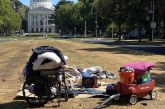
When county officials looked at the CalFresh participation rates in Yolo County, they were stunned to find they were among the lowest in the state on an annual basis. The question that they had to ask was why? The answer turned out to be UC Davis students.
“For a lot of us, we’ve heard this phrase forever, starving students,” Supervisor Don Saylor told the Vanguard. “It’s always a chuckle or a twinkle in the eye like that’s a funny thing.”
Many students choose to go through a period of low income in order to invest in their future, but, as Supervisor Saylor points out, “Many students truly are starving. This is a public university and we have many low income students from families who have put all their resources into the basic educational requirements for their kids.
“That’s a condition that we are hearing more about,” he said.
One of the oddities that we have learned about Yolo County is that, statistically speaking, it has a fairly high proportion of people who are eligible for services like CalFresh but a very low percentage of those people are actually accessing the available services.
Nolan Sullivan is Service Center Branch Director for Yolo County Health and Human Services Agency. He explained that Yolo County had historically ranked in the bottom 5 in the state in terms of participation rates.
County Health and Human Services Agency. He explained that Yolo County had historically ranked in the bottom 5 in the state in terms of participation rates.
Back in 2013 or 2014, he was presenting to the Yolo County Board of Supervisors, and Don Saylor called him on it – he wanted to know why Yolo County had participation rates in the forty percent range.
Don Saylor had first heard about this problem a few years earlier, as Kevin Concanon, at the time the Under Secretary for the US Department of Ag, explained that California was leaving billions of dollars of food support on the table based on low participation of eligible households in the SNAP program.
“California as a state, with our 38 million people, was ranked 50th among the 50 states for participation rates for eligible households,” Don Saylor explained. There were a number of macro-issues at the statewide level that drove the low participation, including fingerprint requirements and income eligibility checks every six months, among other issues.
CalFresh provides low income people who meet federal income eligibility requirements a way to put healthy and nutritious food on their table. The program adds monthly electronic benefits that can be used to buy most foods at many markets and food stores.
The Aggie Compass program provides a variety of ways for students to get food needs immediately. The Fruit and Veggie Up program provides free produce to qualified students two days a week and the Pantry provides non-perishable food and basic necessities such as toiletries. Students are required to present a valid UCD ID Card in order to take up to three items per day.
But as it turns out Yolo County had its own specific issues.
“Yolo County itself was in the bottom five in terms of participation in eligible households,” he said. “That really troubled me. It became an issue that I raised with the board and I raised with our staff.
“It wasn’t simply that there were statewide eligibility issues – there was something deeper afoot in Yolo County,” Supervisor Saylor explained.
It wasn’t hard for Nolan Sullivan to pinpoint the problem. If you looked at Yolo County, most of the major cities like Woodland, West Sacramento, Winters and even the rural areas were running at 80 percent participation. One city was not – Davis. Davis, according to Mr. Sullivan was running at around three percent participation.
The obvious reason was – UC Davis had a huge eligible population but a very low participation rate.
It also turns out there is a bit of a statistical quirk – the reason Yolo County was in the bottom five was that UC Davis represented such a sizable proportion of the county. Yolo County has by far the largest proportion of students in the state, with San Luis Obispo County a rather distant second.
However, while Yolo’s high student population caused the problem to stand out in Yolo County, it seems reasonable to believe that this is a problem across the state at universities.
“It’s not just numbers,” Don Saylor made it clear. It is not a “data aberration.” He explained, “The thing is these are real people. It’s not just numbers, it’s the reality that there are students at the UC Davis campus who are in need.
“We quickly realized that students at UC Davis are eligible for CalFresh if they’re eligible for Work Study,” Don Saylor explained.
However, filling out the application is complicated and cumbersome. The problem was twofold – students didn’t know they were eligible and they didn’t know how to apply. The challenge was to education students about the availability of services and to help guide them through the application process.
How can we increase access and participation among the eligible students at UC Davis to provide them with food support?
Nolan Sullivan explained that, while the government has not figured out how to streamline the application process, some private companies have created apps and other online techniques that have done so.
But the bigger factor has been increasing the presence of full time eligibility workers in the community, and particularly on campus. Recently Yolo County re-opened the administration building on A Street in Davis and, for the first time, there is full time access for Davis residents to services without having to drive to Woodland.
“We had to find a way in,” Don Saylor explained. “We had to find a way to access the students.”
The efforts began rather modestly with Health and Human Services Agency going to campus to participate at the fairs – with information tables. But these were mainly passive efforts.
But, for most of their efforts, “students wouldn’t come.
“We were just kind of scatter-shotting trying to find a way to make a difference,” he said. “We started realizing, we really had to go to where the students are in a way that they can receive the message and access it.”
He explained that they met with then-Associate Vice Chancellor Adela de La Torre, who, along with some her leadership team, brainstormed some ideas.
One of them was to embed eligibility workers in places like the Financial Aid Office and the Student Health Center. “That’s where students come if they have something they want to talk about,” Don Saylor explained.
In a few weeks, the Vanguard will tour the Aggie Compass. But these programs and efforts seem to be starting to payoff.
The data provided by Nolan Sullivan paints a dramatic picture. In July 2016, they had 149 applications and 1221 approved cases. By September of 2018, that number had increased to 853 applications and 2639 approved cases. In just two years, the number of applications have quadrupled while the number receiving assistance has more than doubled.
“We are seeing numbers of students who are applying and becoming eligible,” Don Saylor said. “Whether we can tip that data has become secondary to me… Data is a way to open up the conversation.”
He said, “We don’t think there should be hungry children.” He added, “In this region with its Mediterranean Climate that can feed the world, there should be no reason that any child should be hungry.”
—David M. Greenwald reporting







I read this and thought this was obviously a good thing. But, no, the article’s bent and government staff/leaders goal is to increase participation in a government program. I know Keith O. would have my back on this, but alas, I’ll just curl up in a ball on the battlefield and let my body be riddled with arrows. Draw! Aim! Release!
Alan, I will partially stand in for Keith O. and join you on the battlefield.
David Greenwald said . . .“Many students choose to go through a period of low income in order to invest in their future,”
I believe David’s statement is correct … many students. However, I also believe that many, many, many more students choose to go through a period of low income in order to assert their independence from their parents’ oversight/control. Many students would say “from their parents’ shackles.”
If my belief is correct many of those same students asserting their independence also probably see CalFresh as a concession to the fact that they really are not sustainably and resiliently independent. As a result they choose not to participate.
JMO
Note: When I was growing up in Philadelphia, one of the local radio station disk jockeys named Butterball hosted weekly dances, which they advertised on the radio with the slogan “Choice, not Chance at a Butterball dance!” That expression “Choice not Chance …” has always resonated with me. It resonates now when I think about food insecurity amongst UCD students.
To clarify, actually that comment was paraphrased from Don Saylor.
I don’t really agree with your opinion here. Don’s point to me was that there is a sizable population of students coming from actual low income backgrounds that do not get support from home and are legitimately in need – that’s the population that Aggie Compass and the county are seeking to serve.
David, I don’t disagree with you or Don. There definitely is a population cohort of UCD students that fit that description. My point is that there is a substantially larger cohort that are food insecure due to choices they have willfully made in their life styles … the adolescent/young adult choice to assert their independence and the choice to not avail themselves of the benefits of CalFresh.
I could look into it, but what is the upside for doing so?
The upside is taking the time to know what the problem really is before running out with a knee jerk solution that really doesn’t address the real problem.
Per the article, Don Saylor and Nolan Sullivan were looking at this problem as far back as 2013 – that hardly seems like a knee jerk response. Is it your view that the university and county should not be attempting to better connect students with service because some of them might not be as needy as they appear?
Craig, was it your intent to ask such a loaded question? When did you stop beating your wife?
With that said, the world is not binary. The switch isn’t bipolar. The County and the University have a rheostat to deal with the many shades of grey that exist in the student population.
Let me ask you a loaded question back. If Warren Buffett’s grandson were a matriculated student at UCD, and he, in rebellion to his familial authority structure, declared himself emancipated, and because as a student he had no job, do you believe the university and county should be attempting to better connect him with community/governmental services to address poverty and/or food insecurity?
What evidence do you have that that is what is occurring?
You have got to be kidding Craig. How many UCD students do you know who have emancipated themselves from their parents? That is all the evidence you need.
There is virtually no reason to declare emancipation from one’s parents while an undergraduate … with the one exception being if the student has chosen to get married. To get confirmation of that fiscal reality, all you need to do is talk to a Tax Accountant or Tax Attorney.
Another of my beliefs is that our society is trying to solve food insecurity amongst University students with the wrong tools and with the wrong component of government.
Bernie Sanders and many others have argued for greater public funding of education … up to an including a free college education. While we do not have that now, we do have substantial financial assistance available to the students Don Saylor and David Greenwald have described … students coming from actual low income backgrounds that do not get support from home and are legitimately in need. I strongly believe that the financial assistance that those students qualify for should also include a robust solution to the food security of those students. Investment of financial aid dollars in a student whose diet is deficient is a much worse investment than a similar investment in a student whose diet is “secure.”
Said another way, the way our society doles out financial assistance for education is penny wise and pound foolish. Fix the food security problem of students within the education system, not outside the education system.
“students wouldn’t come” people who are genuinely hungry will come.
Thank you for this article, David! I’m happy to see our agencies and elected officials partnering effectively to address local problems. HHS is doing great work by embedding Services where the students are. Some additional ideas would be to partner with the university during new student registration and consider making benefits education part of work study orientation. On the ground, many of the student support centers are the first to know about students with food insecurity – maybe bring these groups together to brainstorm effective partnerships.
Kristine, wouldn’t it be even better if the University actually addressed its student food insecurity challenges by making CalFresh membership a part of the financial aid packages that are awarded to students coming from actual low income backgrounds?
That’s a really interesting idea, Matt! I don’t see the 2 projects as mutually exclusive. Knowing how the UC works, your idea could take years to implement even with all stakeholders buying in, so Yolo HHS’s current project is a great use of resources that are currently available while exploring more proactive solutions.
I agree Kristine … not mutually exclusive. It really isn’t a “knowing how UC works” issue IMO. It is a State of California funding issue. Look at how quickly the Redevelopment Agency reality in the state changed when the Governor took hold of the issue. Gavin Newsom has talked a lot about how high Education is on his priority list. The possibility of eliminating a lot of waste and increasing higher education outcomes should be very attractive to him … especially since there does not appear to be anyone’s political or bureaucratic ox being gored.
One thing Nolan told me is that students are not normally eligible for CalFresh. They basically have to be working more than 20 hours a week and be on Work Study (here). I’ve requested to know how many are eligible, hopefully will have by the time the second segment of this series runs in a few weeks.
Every day that they hand out free produce in the lobby of the Memorial Union there is a table promoting Cal Fresh, so it is not a matter of a lack of promotion. I suspect that not all students living off of financial aid, part time work and whatever financial support their parents can provide will qualify for Cal Fresh.